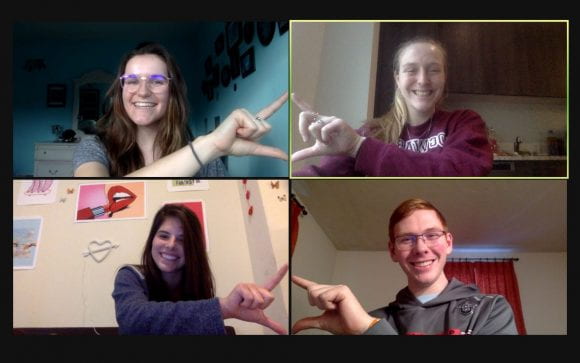IMAGE OF THE WEEK

Congratulations the College of Earth and Mineral Sciences Student Council Benefiting THON, ranking 8th out of all general organizations and raising $39, 721.82 out of the overall total $10,638,078.62. Pictured above, the EMS dancers, Christopher Long, Kayla McCauley, Talia Potochny, and Isabella Urbina, danced for 46 hours from their homes on Zoom. THON executive board members included: executive director, Kayla McCauley; family relations directors, Amanda Byrd and Mandy Sullivan; donor and alumni relations director, Megan Penrod; fundraising outreach, Josie Hoover; alternative fundraising, Ryan Kovacs. Geography students’ names in bold.
GOOD NEWS
Wednesday, February 24, 11:15a.m. Alan Taylor will give a talk on, “Climate and human influences on fire in California forests,” for the spring 2021 Earth System Science Center Brown Bag Series.
Saturday, February 27, at 11 a.m. the Penn State Sustainability Institute’s Environmental Justice Project team, Nebraska Hernandez, Peter Buck, and Nyla Holland, will give a talk on, “Frontiers of Science: Mapping a Just and Sustainable Future for Pennsylvania.” Hernandez is a senior majoring in geography and an officer in the Minorities in Earth and Mineral Sciences student organization. He also serves on the Pennsylvania Department of Environmental Protection’s Environmental Justice Advisory Board.
The American Association of Geographers annual meeting 2021 (April 7–11) preliminary program is live.
Call for Abstracts: The Esri-MUG is planning to hold a one-day virtual meeting on April 22, 2021, which will include a plenary with updates from Esri and user presentations. The presentations can be either a 10-minute lightening talk or a 15-20-minutes traditional talk. To submit a presentation for consideration, send an abstract of your topic and your desired length (10 minutes or 15-20 minutes) to Sandra Woiak at Sandra.Woiak@fairfaxcounty.gov by March 5. Be sure to include your full contact information. Presenters will be notified of acceptance.
Megan Baumann successfully defended her dissertation on February 1, 2021.
COFFEE HOUR
Next Coffee Hour is March 5 with Song Gao on Mapping Human Mobility Changes and Geospatial Modeling of COVID-19 Spread.
If you missed or want to review a previous Coffee Hour talk, video recordings are available on the Department of Geography Coffee Hour Channel on the Penn State mediaspace.
NEWS
Student’s comfort zone is quietly pushing her boundaries
State College native Hope Bodenschatz is looking forward to graduating from Penn State this spring with three bachelor’s degrees and one master’s degree, then starting a position as a research assistant for the director of the New England Public Policy Center at the Federal Reserve Bank of Boston.
“Some of my favorite classes in high school were social studies, history and government,” Bodenschatz said, “but before I got to Penn State, I didn’t understand that these interests, plus my desire to study public policy, were all encapsulated in geography.”
RECENTLY PUBLISHED
Agrobiodiversity’s caring material practices as a symbolic frame for environmental governance in Colombia’s southern Tolima
Mega Dwyer Baumann
Geoforum
https://doi.org/10.1016/j.geoforum.2021.01.002
Agrobiodiversity scholarship broadly examines plant-human interactions in agricultural landscapes and often concerns the governance of seed resources. This article pivots attention away from agrobiodiversity as a set of governable genetic resources to examine how the relational aspects of agrobiodiversity come to symbolize a future vision of environmental governance. Tolima residents are between two significant socio-environmental events: the 2016 Peace Accord ending decades of violent conflict and the development of an irrigation megaproject. This context creates space in which to imagine future governance relations. Drawing insights from political ecology-informed environmental governance and feminist care ethics, I show how caring material practices around native seeds translate into a vision for governance. The symbolic frame of agrobiodiversity promotes an alternative ordering of human-environment relations than that of export-oriented production, which has recently increased in southern Tolima. Methods included 42 interviews, 60 household surveys, and participant observation throughout 12 months. Findings illustrate that the caring material practices of agrobiodiversity particularly in seed exchanges, home gardens, and kitchens become a symbolic frame for environmental governance in which access to land, food, and community cohesion are ensured and protected. This research makes two contributions to the literature of agrobiodiversity. First, drawing on feminist care ethics, I argue that the caring material practices of agrobiodiversity create ‘care-full’ human-environment connections, especially important in the post-conflict context. Second, findings suggest that agrobiodiversity is not simply a set of plant materials to be governed, but also can have a strong symbolic function as a frame for environmental governance.
‘Next generation’ climate change litigation in Australia
Peel, J., Osofsky, H. M., & Foerster, A.
In J. Lin, & D. A. Kysar (Eds.), Climate Change Litigation in the Asia Pacific
https://doi.org/10.1017/9781108777810
Since the conclusion and entry into force of the Paris Agreement and the high-profile Urgenda case, possibilities for exploring new avenues of strategic climate change litigation in Australia have received considerable attention. To date, most Australian cases have involved administrative challenges to projects under environmental laws to have climate change impacts taken into account. While this ‘first generation’ of cases has achieved significant results, there is increasing interest in taking forward a ‘next generation’ of cases that have a broader focus on holding governments and corporations directly accountable for the climate change implications of their actions. This chapter explores the contours of next-generation climate change litigation in Australia, including the drivers for these lawsuits and the potential legal avenues by which they might be brought. Rather than abandoning first-generation challenges — which have targeted Australia’s principal sources of greenhouse gas emissions such as coal-fired power stations and coal mines — we argue that the most fruitful strategy for future climate change litigation in Australia is one that continues to advance lower risk cases building from existing litigation, while simultaneously attempting novel approaches.


